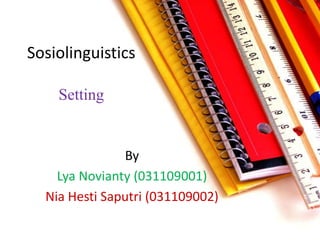
Sosiolinguistics
- 1. Sosiolinguistics Setting By Lya Novianty (031109001) Nia Hesti Saputri (031109002)
- 2. Definition Speech event is an activity that is controlled by a number of rules or norms used in speaking. (Hymes: 1972 in Richard 1995) Speech event is occurring or ongoing linguistic interaction in a form of speech that involves two or more parties, the hearer and the speaker, with one principal utterances in time, place and circumstances. (Chaer and Leonie Agustin: 1995)
- 3. There are eight components in speech event (Dell Hymes), as following: S = Setting and Scene P = Participant E = Ends A = Act Sequence K = Key I = Instrumentalities) N = Norm of interaction and interpretation G = Genre
- 4. Definition Setting is an aspect of the event said the issue related to time, place and situation of ongoing speech. (Hymes: 1972) The time and place may lead to the use of different language variations.
- 5. Examples of setting in speech event. 1. When in public places. 2. Upon meeting in a room. 3. When talking with peers as well as the higher level.
- 6. Reference: Chaer, Abdul dan Leoni Agustina. 1995. Sosiolinguistik Perkenalan Awal. Jakarta: Rineka Cipta. Thank You